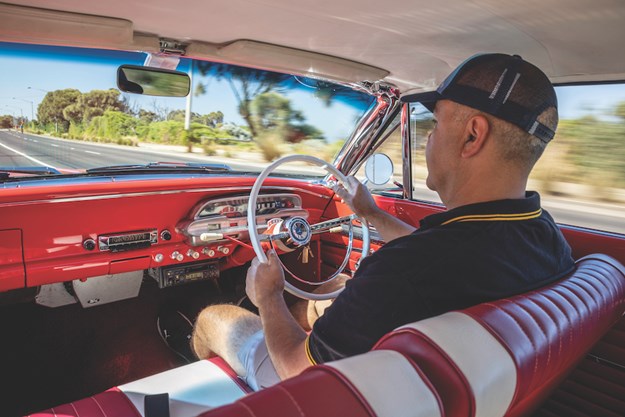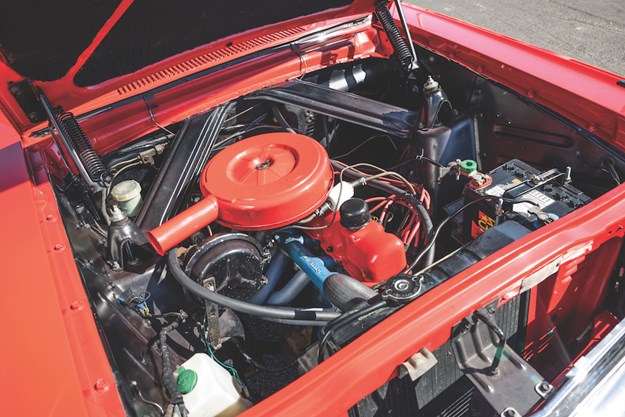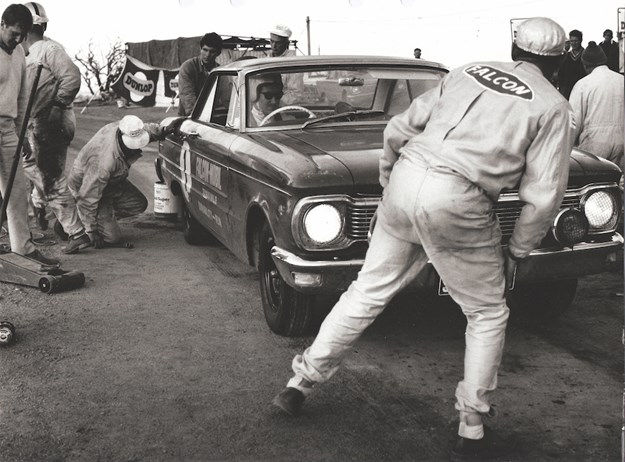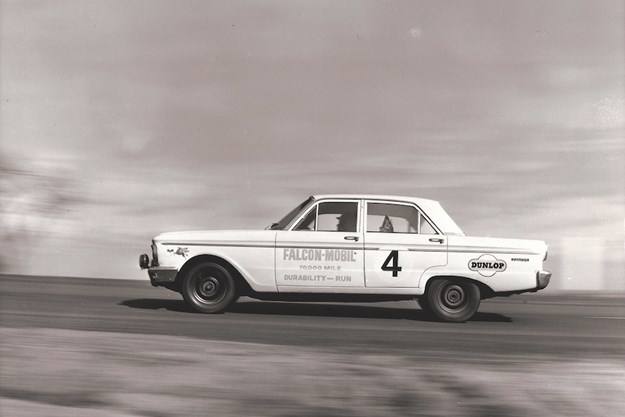Ford XP Falcon - The Company Saviour
It's an unlikely – but true – yarn... Australia very nearly missed out on the Ford Falcon

|
|
Hardtop was a thing of beauty
|
As Dr John Wright and Dave Morley wrote in Unique Cars back in October 2016, the first locally manufactured (as opposed to assembled) Ford was to have been a revised version of the Mark 2 Zephyr, given extra chrome in the Zodiac mode and dubbed Mark 2a.
When Ford Oz boss Charlie Smith and his small team of visiting executives were given a peek at the XK in late 1958 in the US, Smith famously cabled back to Australia: ‘Cancel Zephyr’.
Because the Falcon was lighter, it would be cheaper to build and its project name XK Thunderbird in itself implied more excitement and a sleeker streamline than the Mark 2 Zephyr, which would have been four years old when the first Falcon made its local debut in September 1960.
Fast forward to early 1965 and following the XK, XL and XM models came the Falcon XP, which went on to become one of the most significant Falcons of all time, as I’ll explain soon.
XP models included the entry-model Falcon sedan and wagon, DeLuxe sedan and wagon, Futura sedan and hardtop (coupe), ute, DeLuxe ute and Falcon sedan delivery (van). A new addition was the Fairmont to take on the Holden Premier.
 |
| Rough and ready endurance run |
Visually different from its predecessor the XP wore a squarer front, raised front guards, horizontal bar grille, flatter bonnet and wrap-around front bumpers. Fairmont and Futura models scored bucket seats and in September 1965, the Futura Sedan and Squire Wagon were replaced with the Fairmont sedan and wagon.
Underneath saw a key change with the introduction of the ‘torque box subframe’ boosting the rigidity of the XP, to counteract the perceived flimsiness of earlier models.
On offer were three six-cylinder engines; the base 144ci producing 72kW and 187Nm. Next was the 170 Pursuit with its 170ci engine putting out 83kW and 212 Nm.
The flagship 200 Super Pursuit delivered 90kW and 237Nm from its 200ci engine. Transmissions were a three-on-the-tree manual and for all models above the base, the option of an auto.
Fairmonts ran 14-inch rims to clear their standard front discs with all other sedans and hardtops running 13s unless discs were optioned. Production of the XP range ran from March 1965 to August 1966 with total sales nearing 71,000 units.
Theo Goutziotis is the owner of this beaut Falcon XP coupe. He has owned it since 2010 after nabbing it with the winning bid at a Shannons auction.
 |
| Theo has fulfilled a long-held ambition to get the right coupe. |
He says he wasn’t actively looking for an XP at the time but came it was a case of being in the right place, at the right time for the right car and he bought it.
The shape and lines of the XP coupe attracted Theo from an early age.
"I saw a few of them getting around when I was a kid and even in the early 80s there were a few still on the road," says Theo.
"Some of my relatives had the sedans and wagon versions of the early Falcons but I always liked the coupe. I’d seen a few coupes done up back then and they looked very good."
In his 13 years of ownership Theo hasn’t had to dig too deeply into his pocket, the Falcon copping regular servicing, spark plug changes and the general attention required of an old car to keep it roadworthy, reliable and well maintained.
"I like it as it is pretty much an original spec car and once everything that is old weathered gets to its use-by date it has been replaced with the same part again," Theo says.
"It has been hassle-free and no problems since I’ve owned it and I haven’t had to spend much money on it."
Before Theo bought the XP coupe the previous owner upgraded the engine from its original factory 170ci six to a 200ci Super Pursuit six and added extractors after it came to the mainland from Tassy in 1998.
 |
At the same time as the engine upgrade the XP coupe was given a new paint job, the interior was reupholstered, a factory heater fitted and to cope with the extra grunt, front disc brakes were fitted which Theo reckons makes it a lot more user friendly.
This model is the DeLuxe which is the base coupe model and Theo reckons its only downfall is the front bench seat, not the buckets seats found in the up-spec Futura.
To drive the XP coupe is very smooth according to Theo and even though it is a two-speed auto he reckons it’s pretty responsive. It doesn’t have power steering, but he says it is very light just the same.
"Weekend drives on the Mornington Peninsula are always fun and I go and visit friends while at other times it’s a cruise and a pub lunch. It still turns heads and it’s definitely a keeper," Theo said.
So why is the Falcon XP a significant car?
Well by the time of its launch in early 1965, Ford Australia was in a dire state.
While the Falcon had been well received the suspension and in particular the ball joints of these earlier models couldn’t hack our harsh conditions that were completely different to the silky American roads the underpinnings they were designed for.
Ford’s warranty department was inundated with claims by dissatisfied owners and, despite beefier Fairlane ball joints being fitted, the damage was done with Ford and Falcon on the nose with private and, crucially, fleet buyers. Something had to be done.
In 1963 Wallace Booth was sent to Australia as the new Managing Director by Detroit to either fix the problems or fold the company, so there was a bit of pressure on.
To turn their fortunes around Ford looked to its fresh from the US, new Sales and Marketing Manager William O Bourke (Bill). Bourke had forged a reputation for creating brilliant strategies and he came up with an audacious concept with which to promote the XP and get people talking positively about Ford’s new Falcon.
His concept was the Falcon-Mobil 70,000 Mile Durability Run that commenced Saturday, April 24, 1965.
 |
| Ford went all-out to rescue the local endurance reputation of the Falcon. |
To achieve the 70,000 miles (combined distance) Australia’s top race and rally drivers had to average 70 miler per hour, 24 hours a day for nine days, using a handful of stock XP Falcon sedans and coupes around a circuit at the newly opened Ford Proving Ground on the edge of the granite strewn You Yang ranges between Melbourne and Geelong.
The circuit was daunting, featuring fast right and left sweepers, off-camber corners, a one-in-four hill leading to a blind 90-degree bend and a one-in-seven gradient through sharp right and left bends.
Ultimately the durability run was a roaring success and turned the company’s reputation and perception of the Falcon around. Bourke was an inspirational leader and a legendary figure at Ford, spearheading the creation of the Falcon GT and GT-HOs.
He was appointed to the top job at Ford Australia before becoming President of Ford Asia Pacific. After that he returned stateside.
One of the durability run drivers was at the time an up-and-coming OpenWheeler racer by the name of Kevin Bartlett. We sat down over a coffee or two to chat with him about the event.
Unique Cars (UC) – How did you become a part of the Ford durability run?
Kevin Bartlett (KB) - Billy McLachlan chose a couple of rally drivers and a couple of race drivers and I was recommended as one of the race drivers. Bartlett was teamed in car number 3 with McLachlan, Barry Arentz and Bob Forman.
UC – What were cars like to drive?
KB - The XP Falcons were absolutely stock standard cars. I don’t even recall if we had seatbelts (laughs), but they were terrific to drive. They were loosely sprung, and you could toss them around and up to a limit, do whatever you want with them.
The speeds were pretty much highway speeds and there were minimal gear changes on the three-on-the-tree manual. We pretty much left it in top and I recall seeing about 75 mph maybe 80, with the 170 engine while the 200s were hitting 90 miles an hour but they were far heavier on tyres.
A couple of them rolled due to blowouts and Bo Seton dropped one in front of me in the big red car. I can still see it in the distance and as I came over the hill I saw this thing rolling off the road as he had lost a tyre at high speed. But the Ford crew dragged it back got to work on it and got it going again.
 |
| Hard-charging in a sedan, with a hell of a lot at stake. |
Billy McLaughlin christened our car Blue Bell and the red two-door was christened Steamboat because it kept blowing radiator hoses.
Our car whistled around day and night. I was doing a lot of night stints because I had good eyesight, being around 23 years old at the time. The event took nine days, with Falcon number 3 racing through the
‘Falcon Makes History’ banner around two in the morning on May 3. Our car was the only one not to crash or have any problems and covered the greatest distance.
UC - What was the course like?
KB - Around the back of the You Yangs course it was quite hairy actually and you drove them absolutely flat out. Racing drivers love it when you don’t have to lift off the throttle and up over the top of the hill it was blind, and still flat. I did a dawn run and I’d get to near the top and the sun was blinding you, but I knew where I was, so I kept it flat. It was a great experience for a young bloke and everybody wanted it to succeed.
UC - While it was a durability run, with a roster of race and rally drivers did it turn into a race?
KB - I can say hand on heart that everybody behaved themselves. There was no silly overtaking or suchlike. The challenge was the car and you drove the bloody thing as hard as you possibly could from the time you got in it. That was usually a tank of fuel – sometimes two.
UC - Ford Australia had its future riding on this event. Was there a lot of pressure on the drivers to succeed, and pep talks along the way?
KB - Oh yeah. Les Powell from Ford would spell it out periodically. "This is what we face guys this is our big deal, please do this and do that." Les was pretty good with that. It was either going to be a gigantic failure and the end of Ford in Australia or a huge success and the assurance of its future.
UC - It’s believed Henry Ford turned up for a look flying in and out by chopper. Did you see him?
KB - I was told that he might have even been there for my shift, but I was just focused on that car and didn’t see him.
UC - How much did you know about Ford and the Falcon before this event?
KB - Bugger all, my old man was a Holden dealer (laughs).
UC - Do you remember a lot of publicity and public interest in the run?
KB - Ford’s PR team led by Les Powell was working overtime. But boy what a risk. For crying out loud you can imagine today’s cars there would be gearboxes lying everywhere engines with rods out the side (laughs) modern cars are pretty good, but you stress them to the enth degree… I’d be worried about them.
UC - Looking back what are your memories of the event?
KB - Petty much that I was so much enjoying what I was doing because I was given the license to thrash a car 24-7, which is a feeling that doesn’t happen to many people, and we got paid to do it (laughs).
The Ford Mobil Durability Run remains the most ambitious, risky and successful marketing event in Australian automotive history and one that secured Ford Australia’s future.
Unique Cars magazine Value Guides
Sell your car for free right here
Get your monthly fix of news, reviews and stories on the greatest cars and minds in the automotive world.
Subscribe

.jpg)








